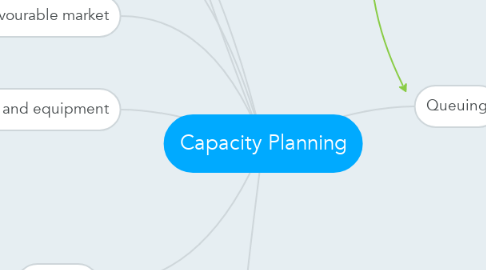
1. selection of machinery and equipment
1.1. capacity
1.2. size
1.3. maintenance requirements
1.4. tolerances of options
2. Capacity
2.1. maximum output of the system under ideal circumstances
2.1.1. rated capacity: measure of max. usable capacity
2.1.2. output or input variable
2.2. many organizations operate at a rate less then capacity to be more efficient
2.2.1. effective capacity: more efficient when not streched to the limit
2.2.1.1. equals expected capacity divided by capcity
2.2.1.2. efficiency: measure of actual output over effective capacity
3. Modelling steps
3.1. mean value and vairability for inter-arrival time and service time are calculated
3.2. other measures are calculated using little's formula
4. favourable vs unfavourable market
5. Deterministic or stochastic analysis
6. static capacity model
7. characteristics
7.1. machine break down
7.2. batchproduction
7.3. setup
7.4. scrap
8. Queuing
8.1. service characeristics
8.1.1. single or multiple server, single phase system
8.2. measuring a queues performance
8.2.1. average time each object spends in the queue
8.2.2. average queue lenght
8.2.3. probability that service facility will be idle
8.2.4. utilization factor for the system
8.2.5. probability of a specific number of objects in the system
8.3. Arrival
8.3.1. pattern of arrival
8.3.1.1. poisson distribution
8.3.1.2. constant
8.3.2. Size of arrival
8.4. Costs
8.4.1. Trade of waiting costs and service costs
8.5. queuing models
8.5.1. queuing models to get probabilty that there are 0 objects in the system
8.5.1.1. arrivals per period
8.5.1.2. serviced per period per server
8.5.1.3. average time in system
8.5.1.4. time between unit service requirements
8.5.2. economic analysis
8.5.2.1. waiting costs
8.5.2.2. savings with new server
8.5.3. little's law

